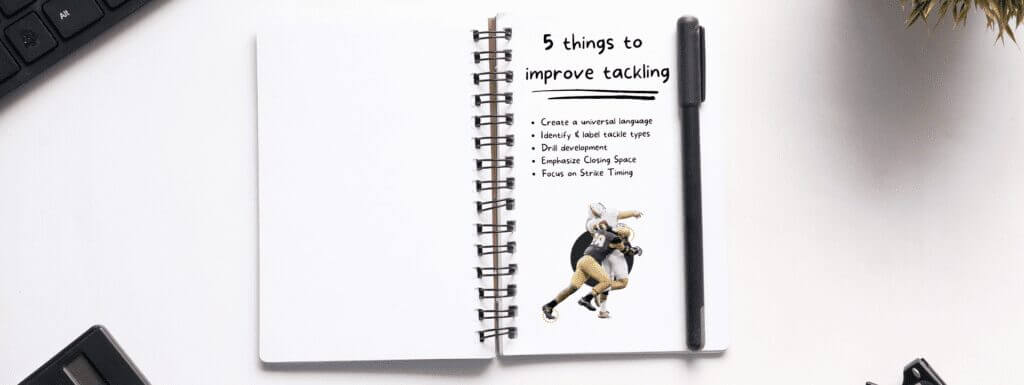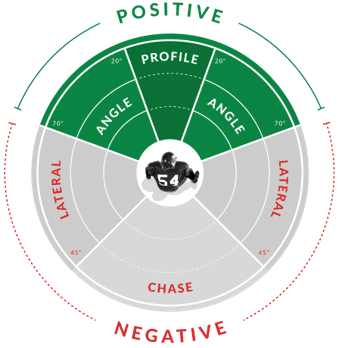5 Things You Can Do To Immediately Improve Your Tackling

Your team’s ability to tackle is one of the most critical factors in football. If you can’t tackle, you won’t be able to stop your opponents from scoring. Coaches often say that tackling is primarily intuitive, but by breaking down the process into repeatable elements, you can consistently produce safe, effective, and efficient tacklers.
Here are five tips that can help you immediately improve your tackling:
This strengthens coaches’ ability to translate information effectively and reinforces proper practice habits while avoiding player confusion.
Coaches must first identify the key concepts and terms they want their players to learn to create a universal language. Then, they can use these terms consistently when teaching and reinforcing the skills.
A universal language allows for clear communication of expectations. Players need to know what’s expected of them before practice starts to prepare mentally for each drill. Coaches should provide players with clear descriptions of what they need to do during each drill and how much time is allotted for each task.
Understanding the situations your defenders face most of their time in games will increase players’ awareness and allow the coach to make more informed decisions when planning tackle drills.
Tackling is an essential skill that every player should be able to perform, regardless of position. Still, identifying the situations that players encounter can help tailor your coaching instruction to match that player’s strengths and put them in more favorable positions.
Once you know your players’ situational strengths and weaknesses, creating drills that develop their skills in those areas is much easier and impactful.

A systematic approach to teaching tackling allows for better athlete skill retention and confidence, which translates to more consistent performance on game day. We have broken them into categories that will enable varied but purposeful instruction to keep athletes engaged and challenged.
- Technical Drills: Drills that focus on improving technique and fundamentals are essential in developing great tacklers. These drills should not only focus on proper technique but also consistency.
- Decision-Making Drills: Decision-making drills help to train athletes to make quick decisions under pressure and increase their understanding of leverage points during contact situations.
- Game-Based Drills: Game-based drills allow athletes to “game test” their ability against live ball carriers in realistic situations with myriad of potential decisions. These drills will enable them to learn from mistakes in a low-risk environment before they occur during games.
Continuous pursuit towards the ball carrier and reaction to obstacles are essential to setting your tacklers up for success. With effective tracking, players will maximize contact and limit preventable yards.
When a defender reduces the space between himself and the ball carrier, they effectively take away options and force them into a decision. Closing space also has the added benefit of lowering what we call “preventable yards,” which is the hidden yardage gained by the offense when the defender waits on their heels before making contact.
This concept does not mean the tackler should be overly aggressive in moving toward the ball carrier. However, by continuously gaining ground in a controlled manner, they can improve their chances of maximizing contact with their chest or shoulder pads.
5. Focus on proper strike timing:
Striking with the shoulder and a loaded jab punch will increase power and control, which limits Yards After Contact and broken tackles
Focusing on proper strike timing emphasizes the moment of impact between you and the ball carrier. This is when you should apply force to your opponent to get him on the ground as quickly as possible. By looking at the knee-to-hip ratio upon contact, coaches can determine whether the defender was either:
a. Early – lunging ahead with hips far out in front of knees.
b. Late – sitting back in their stance with the hips behind the knees.

The best way to improve these abilities is through repetition and observation. The more situations you see in practice, the more comfortable your athletes will become in reacting quickly and timing up contact effectively.
At all levels, football is a game of inches. An inch here or there can make all the difference in the world.
In that same way, an inch here or there can make all the difference in your tackling efficiency. If you improve your tackling by just one percent, you could save yourself from getting beat on crucial plays that matter most: third-down conversions, red zone opportunities, and goal line situations. On top of all that, improving your tackling will increase team confidence and morale — both of which have proven to correlate directly with winning games.
To learn about more tips and things you can do to improve your tackling and take your program to the next level, check out our Digital Tackling Academy.
